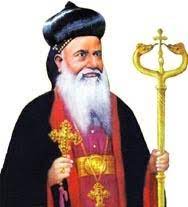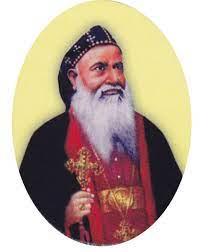Pulikkottil Joseph Mar Dionysius II | July 12 I Malankara Sabha Thejus – Mar Dionysius V

Joseph Mar Dionysius II was born on November 12, 1833, in the Pulikkottil family of Kunnamkulam near Trichur. His father was Tharu Kurien, the nephew of ‘ Pulikkottil Joseph Mar Dionysius I’ (the founder of the Old Seminary at Kottayam) and mother, Thadamma, the brother’s daughter of Paingamukku ‘Kuthuru’ Geevarghese Kathanar. The boy was named Joseph (Ittoop)after his venerable grand uncle Dionysius I. Joseph started his education at the age of five. In 1843, under the guidance of his uncle Joseph Malpan, he began his education in theology and Syriac, staying at the Arthat St. Marys Church, Kunnamkulam. Young Joseph was a keen and eager student and eventually even acquired knowledge of Hindi and Sanskrit.
At the age of 13 on 5th October 1845, Joseph was ordained ‘Kooroyo’ by Mar Dionysius IV Cheppaud at the Kothamangalam Mar Thoma Cheriapally. After his ordination, Joseph returned to his native place, Kunnamkulam and continued his theological studies under his uncle. In 1849, Stephanos Mar Athanasius, ordained him to the order of Full Deacon at Arthat Church. Later Dn. Joseph accompanied Yuyakim Mar Kurillos as his translator and secretary. About a year later, on 18th August 1852, Dn. Joseph was ordained as priest at the Chalassery Church near Kunnamkulam by Yuyakim Mar Kurillos. The first holy Qurbana by Fr. Joseph was offered at the St. Lazarus Church, Chiralayam, Kunnamkulam.
Fr. Joseph was ordained during the period, when the Anglican missionaries with the support of British resident of the time were trying to bring in reformation in the Malankara church through various means. Because of this, many of the Churches in Central Travancore (Southern Kerala) including the old Seminary of the Church at Kottayam, came under the influence of the Church Missionary Society (C.M.S). Mar Dionysius IV (Cheppaud) who extended co-operation to the missionaries in initial stages later severed the relationship with them. Even a partition of the joint properties was effected in 1840. However, a group led by Abraham Malpan of Maramon within the Church continued with the reformation efforts. This group succeeded in getting Dn. Mathews, nephew of Abraham Malpan ordained as bishop Mathews Mar Athanasius by Patriarch Elias of Antioch in 1841. On return to Malankara, Mar Athanasius also succeeded in receiving a Royal proclamation as the Malankara Metropolitan against Dionysius IV (Cheppaud 1825- 1855). The reformist activities of Mar Athanasius were not acceptable to many in the Church, and it was decided to get Fr. Joseph Pulikkottil ordained as bishop to counter Mar Athanasius.
On 30th May 1864, Fr. Joseph Pulikkottil boarded the ship from Cochin. Fr. Joseph was elevated to the order of ‘Ramban’ by HH Patriarch Yaqoob II, on Saturday 6th May 1865 and on 7th May 1865, he was ordained as Metropolitan with the title “Mar Dionysius “at the Church of the ‘Mother of God’ at Amida in Turkey.
On his return to Malankara, Pulikkottil Thirumeni appealed to the Travancore Government, for revoking the Royal Proclamation, issued earlier, in favour of Mar Athanasius on the ground that he was the legitimate Metropolitan of Malankara, consecrated by the Patriarch. Though this appeal was rejected by the Dewan of Travancore, he asked Mar Dionysius to sue against Mar Athanasius in respect of any one church, so that the findings of the court on the matter might be applied regarding all churches. This was the beginning of litigations in the Malankara church. But Thirumeni could not win the case. To get over the difficulties caused by the reformation and to support Mar Dionysius V against the reformers, the Church invited the Patriarch to come over to India and the HH Patriarch Peter III of Antioch came to Malankara in 1875.

The historic Synod of Mulanthuruthy was convened under the president ship of HH the Patriarch on 28th June 1876, which continued for three days. Chathuruthil Geevarghese Ramban (Parumala Thirumeni),was also present in the meeting as the secretary to the Patriarch. The synod decided to form a ‘Syrian Christian Association’, comprising of representatives from the parishes in Malankara, to manage the affairs of the Church. Mar Dionysius was unanimously chosen as the President of the Association. The Church was later divided into seven dioceses and six new bishops were ordained to rule each diocese. On 27th August the same year, ‘Holy Mooron’ was consecrated for the first time in Malankara by HH the Patriarch, assisted by the Malankara Metropolitan Pulikkottil Mar Dionysius. HH the Patriarch left for Mardin in May 1877.
The legal fights against the reformers ended up in the final judgment of the Travancore Royal court in 1889 which was in favour of Pulikkottil Thirumeni and recognized him as the real Malankara Metropolitan. The judgement also lead to the final parting of the reformists as the ‘ Marthoma Syrian Church ‘ In 1901, Golden jubilee celebration of Pulikkottil Thirumeni’s priestly ordination was celebrated majestically at Kottayam. It is recorded that in recognition of his dedicated services for the cause of the Malankara Church, a ‘Mangalapathram’ signed by all the Church prelates and about 85000 laymen, was submitted to Thirumeni at the function.
In November 1902, Parumala Mar Gregorios entered heavenly abode. Parumala Thirumeni’s demise at the most unexpected time was a severe blow for Pulikkottil Thirumeni as it was Parumala Thirumeni whom he considered as his successor. On the 30th memorial day of Parumala Thirumeni, the Holy Synod of the Malankara Church convened by Mar Dionysius, selected Vattasseril Fr. Geevarghese Malpan and Kochuparambil Paulose Ramban of Mulanthuruthy as Metropolitan-designates. The ordination of the new bishops was held on 31st May 1908, by HH Patriarch Abdulla at the Dayara of Markose in Jerusalem as Mar Dionysius Geevarghese Vattasseril and Mar Kurillos Paulose.
Through his unstinting effort, spiritual organizations like Sunday School and Students movement, and Church institutions like Parumala Seminary, Kunnamkulam Sehiyon Bungalow, Kottapuram Seminary and M.D. Seminary developed. He was a courageous, popular, spiritual leader, who guided his followers through one of the most difficult times in the history of Malankara Church. He dedicated his life to the church. Gifted by his integrity, and loyalty to the church he was even prepared to lay down his life for the church and its beliefs.
After serving the Church as a high priest for nearly four and half decades in its true apostolic traditions, Pulikkottil Thirumeni was called to his heavenly abode at the age of 76 on Sunday, 11th July 1909. His body was entombed on 12th at the northern side in Old Seminary Chapel at Kottayam. Church historians’ records that it was under the able leadership of Pulikkottil Mar Dionysius, the Malankara Church started functioning in an organized form. Hence it is rightly stated that Thirumeni is the architect of the Malankara Orthodox Church in the modern times. The life of Pulikkottil Thirumeni was one dedicated to the Glory of God and the progress of Malankara Church.

0 Comments